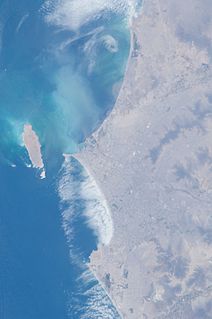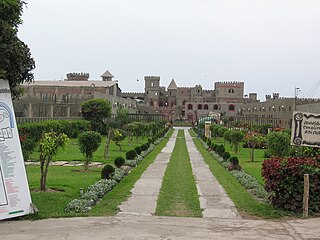
The Lima metropolitan area, is an area formed by the conurbation of the Peruvian city-provinces of Lima and Callao. It is the largest of the metropolitan areas of Peru, the seventh largest in the Americas, the fourth largest in Latin America, and among the thirty largest in the world. The conurbation process started to be evident in the 1980s. The metropolitan area is composed of six subregions. These are Lima Norte, Lima Sur, Lima Este, Residential Lima, Central Lima, and Callao. Its estimated 2018 population is 12 million according to INEI statistics.

Chinchasuyu was the northwestern provincial region of the Tawantin Suyu, or Inca Empire. The most populous suyu, Chinchasuyu encompassed the former lands of the Chimú Empire and much of the northern Andes. At its largest extent, the suyu extended through much of modern Ecuador and just into modern Colombia. Along with Antisuyu, it was part of the Hanan Suyukuna or "Upper Quarters" of the empire.

Huaura is one of nine provinces of the Department of Lima on the Pacific coast of Peru. It has a population of about 180,000 inhabitants. It is bordered by the province of Barranca and the Ancash Region in the north, the provinces of Cajatambo and Oyón and the Pasco Region in the east, the province of Huaral in the south and the Pacific Ocean in the west. The capital of the province is Huacho.

Ferrocarril Central Andino (FCCA) is the consortium which operates the Ferrovías Central railway in Peru linking the Pacific port of Callao and the capital Lima with Huancayo and Cerro de Pasco. As one of the Trans-Andean Railways it is the second highest in the world constructed by the Polish engineer Ernest Malinowski in 1871–1876.

Huaral is a town in central Peru, capital of the Huaral Province in the Department of Lima.

The Huaral Province is one of the nine provinces in the Lima Region of Peru. It was created by Law No. 21488 on May 11, 1976 by president Francisco Morales Bermúdez out of eight districts of the Canta Province and four of the Huaura Province. Geographically, its territory extends around the valley of the Chancay River from the mountainous frontier of the Pasco Region and Junín Region up to the Pacific Ocean.

Chancay District is one of twelve districts of the province Huaral in Peru.

The Lima culture was an indigenous civilization which existed in modern-day Lima, Peru during the Early Intermediate Period, extending from roughly 100 to 650. This pre-Incan culture, which overlaps with surrounding Paracas, Moche, and Nasca civilizations, was located in the desert coastal strip of Peru in the Chillon, Rimac and Lurin River valleys. It can be difficult to differentiate the Lima culture from surrounding cultures due to both its physical proximity to other, and better documented cultures, in Coastal Peru, and because it is chronologically very close, if not over lapped, by these other cultures as well. These factors all help contribute to the obscurity of the Lima culture, of which much information is still left to be learned.
Lake Paucarcocha is a lake in Peru located in the Lima Region, Yauyos Province, Tanta District. It is situated at a height of about 4,284 metres (14,055 ft), about 6.5 km long and 0.87 km at its widest point. It has a catchment area of 213.6 km2. Lake Paucarcocha lies south of the Pariacaca mountain range, between P'itiqucha in the northwest and Piscococha and Chuspicocha in the southeast. Moreover, the lake is located inside the valley of the Cañete River, being this river its primary inflow and outflow source.
The Ligas Provinciales del Peru are the Peruvian football lower divisions. They are administered by the Local Federations. The level immediately above is the Ligas Departamentales.
Ichma, Yschma, Ychsma, Ishma, or Ishmay was a pre-Inca indigenous polity later absorbed by Tawantinsuyu and reorganized as a wanami (province), the Ishmay Kingdom was located south of Lima, Peru in the Lurin valley; it later spread north into the Rimac valley. The Ichma culture was formed around 1100 AD following the breakup of the Wari Empire. Ishma autonomy lasted until around 1440 when they were absorbed into the Incan Empire.

The Chancay were a pre-Columbian archeological civilization which developed between the valleys of Fortaleza, Pativilca, Supe, Huaura, Chancay, Chillón, Rimac and Lurin, on the central coast of Peru, from about CE 1000 to 1470.

Incahuasi or Incawasi is an archaeological site in Peru. It is located in the Lima Region, Cañete Province, Lunahuaná District.
Challwaqucha may refer to:

Awkin is a 5,183-metre-high (17,005 ft) mountain in the Andes of Peru. It is located in the Lima Region, Cajatambo Province, on the border of the districts of Cajatambo and Gorgor, and in the Oyón Province, Oyón District.





















